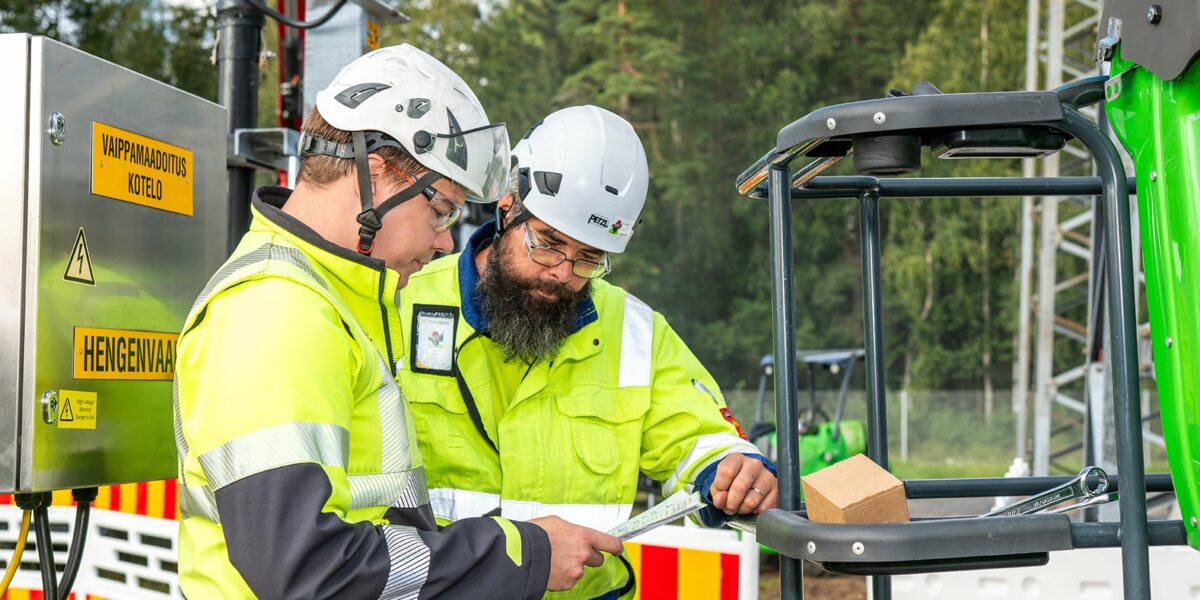Personal safety is the top priority in all activities on Fingrid’s worksites. Construction of the main grid involves working with high voltages, and avoiding all accidents and near misses is essential.
“Our target for main grid worksites is zero accidents. In addition, there should be no hazards to third parties near transmission lines,” emphasises Jani Pelvo, person in charge of operation of electrical installations at Fingrid.
Safety equipment, safety distances from live components, correct working methods, and compliance with instructions are essential when working with high voltages.
Fingrid holds separate electrical safety training events to cover these and many more aspects of electrical work. The events are tailored for people working on high-voltage installations.
“We add additional emphases to our safety training as challenges arise.”
“In our opinion, the statutory electrical safety training is not comprehensive enough for high-voltage operations, so we include additional emphases in our training courses as challenges arise. That is why it is important to report all near misses and other observations to us,” Pelvo says.
Communication and orientation becoming more necessary
Taking other working groups into consideration is an integral aspect of worksite safety.
“Tasks need to be coordinated so that it is safe for everyone to work, especially on large worksites. Coordination and communication are necessary to avoid unforeseen situations and damage,” Pelvo says.
Paavo Kaija, HSEQ Manager at Enersense, emphasises the importance of communication in all activities on electrical worksites as the green transition proceeds – the more investments are made in renewable energy and new types of power plants are built, the more worksites and different operators there are.
“For example, wind power projects involve many new types of installations, with operators working in parallel. It is no longer a case of building a single line – there are multiple connections and branches, some made at the same time. This means that everyone must focus more on safety and share information,” Kaija emphasises.
Continuous training within working groups is a big part of ensuring safety. Enersense has increased the number of worksite meetings it holds.
“We have a worksite meeting every morning, not just at the start of a project. Every task is reviewed individually. In other words, we break down the job into small parts during orientation,” Kaija says.
Clarity is the focus when writing instructions so that international and temporary workers receive all the most important information.
”Our work plans now include a lot of pictures, so safety is not affected, even if we do not speak the same language fluently.”
“Our work plans now include a lot of pictures, so safety is not affected, even if we do not speak the same language fluently. Finnish norms differ from international ones, but pictures are clear and unambiguous,” Kaija says.
Where international working groups are concerned, it is also important to point out that Finland’s electricity grid is unusual: induced voltage behaves differently than, for example, in the Baltic countries. In Finland, transmission lines often run long distances in parallel, presenting a risk of induced voltages in transmission lines in the same right-of-way as the work location.
“It is essential to understand the need for additional earthing to ensure the work location is unenergised. This may surprise some foreign workers, so it should be emphasised during orientation,” Kaija says.
Additional earthing requires concentration
Planning and implementing additional earthing is a critical safety issue on which Fingrid now aims to place a special emphasis. Inadequate planning and implementation of additional earthing has led to hazardous situations on worksites.
“For example, a group may have planned the additional earthing correctly, but the installation technician failed to follow the plan. We are now providing additional training and requiring additional earthing to be reported to reduce the number of similar incidents and highlight the importance of the issue,” Pelvo says.
Service providers have made additional earthing plans on electrical worksites for years, but the need for additional earthing became a separate mandatory field on the online safety declaration form at the start of June.
“Groups must evaluate the need for additional earthing when they complete the safety declaration form. If additional earthing is necessary, they should describe where it is needed and how it will be implemented. Alternatively, they can attach a separate additional earthing plan,” says Veijo Siiankoski, Grid Maintenance Manager at Fingrid.
Additional earthing is an important safety measure. It can ensure that a work location in a high-voltage installation is unenergised and eliminate hazardous induced voltages in work locations.






